Back to page 1
The Exterior
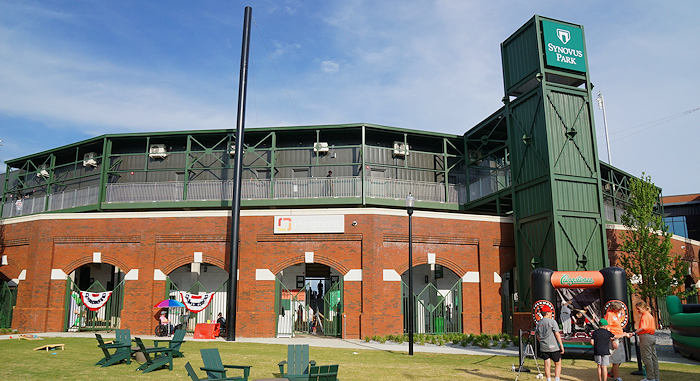
As we turn our focus to the architecture of Synovus Park, we need to address a question: Is this a new ballpark or an old one? There is no doubt that this is a combination of new construction and old structures, but are there enough new features for this to be thought of as a new park?
Charlie O’Reilly, who has attended games in over 400 pro ballparks, says this is a renovation. “When I got there, I saw that the superstructure of the main grandstand, including the portals, appeared unchanged from my 1997 visit, including concrete that seemed to be original to 1951.”
Great points, but my definition is different. When I walked into Synovus Park, I felt like I’d never been there before. Except for the roof, nothing looked familiar to me, especially because of the new construction in the outfield.
As I made the rounds outside of the park’s exterior, the brick archways behind home plate gave me more of a sense of familiarity, but still it didn’t seem at all like the stadium I’d visited in 2003.
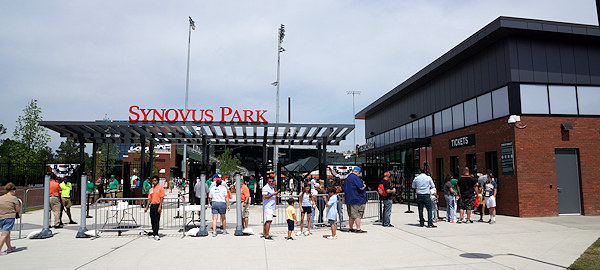
The first part of the ballpark you see from the parking lots are the new structures beyond right field (above). This houses the ticket windows, merchandise store, and behind them, the home team’s clubhouse. That’s adjacent to the “performance” building. Next to the store is the main entry to the ballpark. Remember, all of the parking is between the ballpark and the civic center. None is behind the infield.
It was obvious that special attention was paid to the selection of the bricks for these new structures, as they were complementary to the old parts of the park.
The art on the exterior walls of the Georgia Power Performance Center building is very nice (below), but it’s too bad that there’s a big utility box in front of the COLUMBUS lettering, preventing you from photographing it straight on.
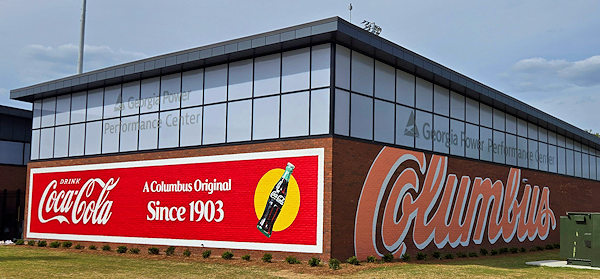
As you travel counterclockwise around the park, you’ll next spot a fenced-off skateboard park between the back of one of the video boards and the outer perimeter fence. I have no idea if this will be re-activated at some point, but no aspiring Tony Hawk can access it now. Next to this is the area used for storage of the batting cage and groundskeeping equipment. This is beyond the left-field wall.
One thing you don’t see is a concrete outer outfield wall, like there still is at Rickwood Field in Birmingham. There used to be one, approximately 400 feet from home plate down the foul lines (it took a massive blast to clear these walls back in the day). “Those walls weren’t structurally sound, so we couldn’t have kept them if we wanted to,” noted Ford. “When it came time to remove them, the workers were almost able to push them over without needing equipment.” So, yeah, those didn’t need to be kept.

As you round the left-field corner near the foul pole, you almost have to walk on the travel lanes of U.S. Highway 280 (above). This spans the Chattahoochee River, connecting Phenix City, Alabama and Columbus.
Behind third base (below) you can see the brand-new picnic areas, which were a huge hit during the opening homestand. Notice that there are gates here. They aren’t used as an entrance to the park, but I suppose they could be used as an exit following games.

Behind home plate, you see the image at the top of this page. These beautiful archways date back to at least the 1950s, and I love that they were retained. These represent somewhat of a Golden Age for construction materials. So much of the time, you see newer ballparks trying to make their new masonry look old. Here they simply used the original structures, thank goodness.
I should add that this fairly flat grassy area would seem to be attractive for some kind of development. That won’t happen, though, as Ford explained that a huge sewer line runs directly underneath the ground there. There also is no entry gate behind home plate. That’s because there is practically no parking near here.
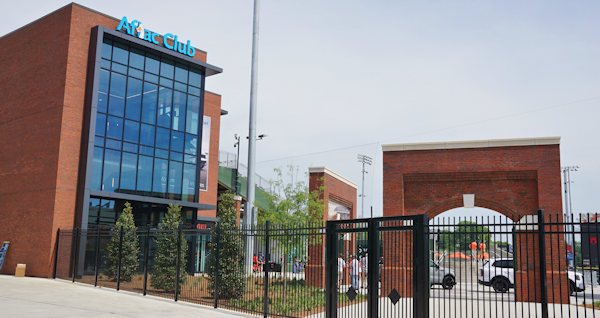
Behind first base (above) is new construction holding the Aflac Club on the third floor, team offices on the second and the commercial kitchen on the ground floor. Note the huge “Legacy Arches” that used to be where fans would enter the ballpark. More on them when we discuss the park’s interior.
And that brings us back around to the main entryway down the first-base line.
Now let’s check out the interior design.
The Design
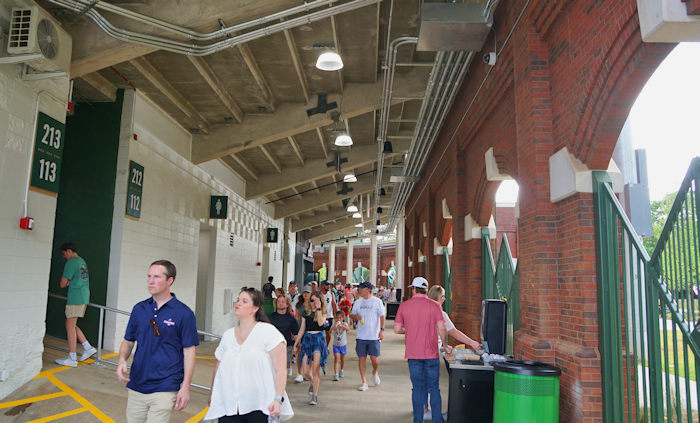
As we examine the interior of Synovus Park, let’s recap what was retained from the structure known as Golden Park.
As we’ve discussed, the gorgeous brick arches all around the concourse behind the infield were kept, as were the Legacy Arches down the first-base line. The concrete that forms the main seating bowl was retained, but not the seats themselves. And perhaps most noteworthy is the massive roof covering the stands behind home plate. “We looked at all sorts of options of what to do with the roof,” Ford noted. “We talked about reducing it, removing and replacing it, and just not having one. In the end, any option other than keeping it was just too expensive.”
A roof like this one is how ballparks were typically built 75 or 100 years ago. Not any more, simply because of the enormous cost.
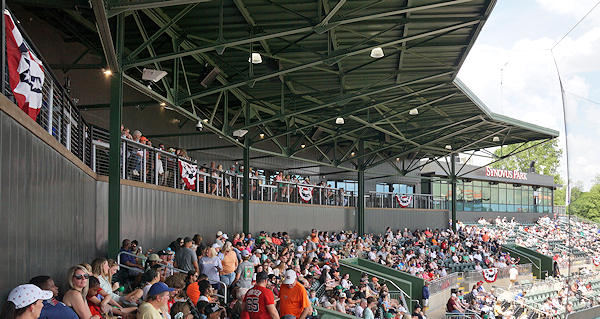
One reason that the existing roof created a conundrum was because of the desire to replace the very unimpressive suites that were all the way at the back of the grandstand, tucked up under the roof. The new suites are one of the most innovative aspects of the new construction here. You access them from a small concourse behind the grandstand, and you enter a scaled-down air-conditioned space where the food is served. You then walk out onto a patio at the same level as the enclosed space. There are no tiered seats like in almost every other stadium and arena in the world, just a flat surface with patio furniture (selected by Canopy).
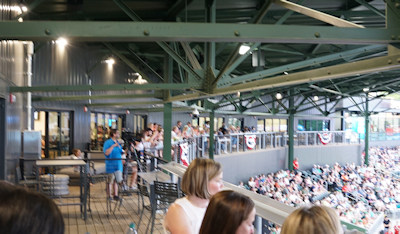 The only other ballpark that comes to mind with such a design is Amarillo … but there the patios block the view from the pressbox, which is situated all the down the first base line on the upper level. In my opinion, a very bad idea. At Synovus Park, they don’t block the view from any other part of the venue. And the view of the field is very good.
The only other ballpark that comes to mind with such a design is Amarillo … but there the patios block the view from the pressbox, which is situated all the down the first base line on the upper level. In my opinion, a very bad idea. At Synovus Park, they don’t block the view from any other part of the venue. And the view of the field is very good.
True, the underside of the roof isn’t very far above your head, and there are girders that you need to navigate around, but I absolutely love how this concept was executed here.
One aspect of retaining the same concrete grandstands as before is that the first few steps into the seating sections above the cross aisle are very steep — certainly steeper than if you were building a ballpark from scratch. “You run into a problem if you decide you want to replace those steps (with something less steep),” said Ford. “If you start ripping out that concrete, you don’t know what you’re going to find underneath it, and you might have to keep removing and removing.”
 To address this scenario where you feel like you’re climbing a ladder rather than stairs, Populous added railings everywhere there are steps. They also did this along the aisles and in the portals between the main concourse and the seating bowl. This issue with steep steps is similar to the situation at Rickwood Field. There the architects elected not to attempt repairs due to the historic nature of the building — and those steps are more rickety than the solid ones in Columbus.
To address this scenario where you feel like you’re climbing a ladder rather than stairs, Populous added railings everywhere there are steps. They also did this along the aisles and in the portals between the main concourse and the seating bowl. This issue with steep steps is similar to the situation at Rickwood Field. There the architects elected not to attempt repairs due to the historic nature of the building — and those steps are more rickety than the solid ones in Columbus.
All of Golden Park’s seats were replaced as part of the rebuilding, but even that came with complications. The original seats — many of which had been replaced over the decades — were bolted directly into the concrete. After ripping the old seats out, the idea of re-bolting new seats to the same concrete was fraught with peril. As Ford explained, you didn’t know what was just beneath the surface. Old bolts, hollow spaces or worse could have made attaching new seats a hit-or-miss affair. The solution was to go with a seating arrangement where a single horizontal beam was mounted to the concrete, and the seats themselves were attached to the beam — much like was used on the steep grandstand of the ballpark built in Granville, West Virginia, used by WVU and by the MLB Partner League Black Bears there.
In Columbus, this meant another compromise brought about by “old versus new.” If a brand-new park was to be built from scratch, you would incorporate the kind of legroom modern-day fans expect. That wasn’t possible here, so don’t expect a lot of room around you when you are in your seat.
The arrangement of the seating sections hasn’t changed. The areas behind the uncovered seats that used to be open now contain brand-new construction. On the third-base side is a spacious new pressbox, with two modern broadcast booths and an enclosed space for production.
On the first-base side is the new structure containing the team offices and, on the top level, the Aflac Club. This beautiful lounge (below) is huge and can be used by season-ticket holders or can be rented out for wedding receptions or community events. When you exit the club on the field side, you walk right onto the back concourse at the top of the seating section. Great planning.
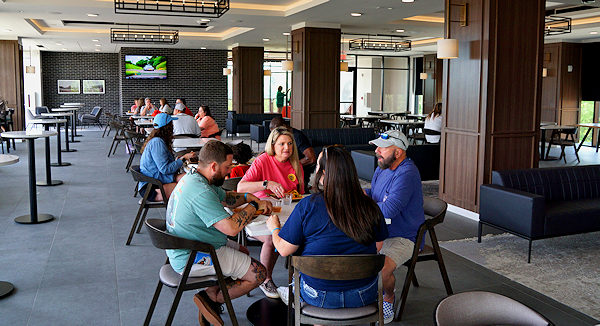
And at the top of the grandstand in front of the lounge are six new rows of mesh seats with extra legroom. Members of the Aflac Club have access to these seats. The vantage point of the playing field from here is, by the way, excellent.
Now that the entry gate is no longer right behind first base, there is space for a picnic area for groups. This is actually true along both foul lines. And these are proving to be very popular. By the way, there are no grassy berms here.
Between the Aflac Club building and the first-base picnic area are the three immense Legacy Gateway Arches (below). This used to be where you would enter the ballpark. They were retained, and on them is really well-done artwork and plaques describing the history of Golden Park and of baseball in the region. As Mayor Henderson remarked, this “leveraged a lot of history. It all fits.”
“Part of respecting the history of a place is trying not to fake it,” added Geoff Kornegay, the lead designer on the project from Populous. “From the get-go, the design team was committed to being honest about what was historical and what was new. Original elements have fine brick details, repeating archways, and traditional proportions, while the new structures are contemporary in form and design. This ballpark has lived many lives, and telling its story requires all of them to be celebrated.”

Near the arches, a new stairway was devised to connect ground level to the cross aisle in the grandstands. Next to it is the ramp for wheelchair access.
There isn’t a 360-degree concourse here, because there is no outfield seating and no services for fans to access beyond the outfield walls.
The bullpens are end-to-end beyond the left-field fence. The dimensions are 325′ down the third-base line, 362′ to left center, 400′ to dead center, 352′ to right center, and 325′ to the right-field foul pole. The fence is a uniform 8′ tall across the outfield. Now, these dimensions wouldn’t seem to make this a “pitchers’ park,” but the locals voiced consistent concern about the lack of offense during the opening homestand. In fact, not a single home run was hit by the home team during those six games.
So you might not see a ton of offense, but what is your experience likely to be when you come to see the Clingstones play?
The Essentials

First, what does it cost to attend a Columbus Clingstones game? There aren’t a lot of parking options, so you’re most likely going to pay the very reasonable $5 to park in the huge lots between the ballpark and civic center.
If you order your tickets in advance, they will be a little cheaper … but be advised that there are *eight* different prices in the grandstand, depending on your desired section. And the prices are different if you want to attend a weekday game versus one on the weekends.
During the week, seats above the cross aisle will cost either $13, $15, $17, $19.50 or $20.50. These reflect how close you are to being behind home plate. Between the cross aisle and field, the seats cost $22.50, $25.50 or $28. For the most part, add $2 for weekend games.
Note that Synovus Bank customers can save $1 per ticket for any Sunday game as long as they make the purchase in person at the box office and use their bank credit or debit card.

Golden Park never had group areas like they do now. The picnic area on the first-base side is called the Peach Pit, and groups of at least 20 can spend either $28 or $30 per person, depending on the day of the week, for the hot dog and hamburger menu, or $7 higher for the BBQ selections. The menu options and pricing are the same at the W.C. Bradley Backyard on the third-base side (above).
One of the suites is held back for nightly rentals. The cost is $1,200 or $1,300 (depending on the day of the week) for up to 25 fans.
 The merchandise sold in the store at the ballpark isn’t cheap, but affordability isn’t the issue. It’s availability. By the end of each game during the opening homestand, complete racks of merch sold out. The demand for the cute peach-colored apparel and mascot-shaped novelties was unmistakable.
The merchandise sold in the store at the ballpark isn’t cheap, but affordability isn’t the issue. It’s availability. By the end of each game during the opening homestand, complete racks of merch sold out. The demand for the cute peach-colored apparel and mascot-shaped novelties was unmistakable.
Pete Laven, the front-office veteran who’s the GM in Columbus, told me that one of the hottest sellers has been jerseys, especially in peach (“We’re the only team in pro sports with peach as our primary color,” he pointed out). The jerseys go for $136.
Men’s tees from premium maker 47 cost $35 and $50, and are $45 for ladies. Kids tees are $24 and $30.
Fitted caps are $43, and adjustable ones are $35. Most men’s polos are $50, but the very much in-demand peach ones are $75.
Personally, I couldn’t resist the combination of a peach-colored polo and a green-with-peach-accents fitted ballcap. I don’t buy apparel from every ballpark I go to (I’d be broke), but I found this to be a can’t-miss look.
I like the way concessions are offered here. Some teams (like Hub City) have a few extra-large stands. In Columbus, there are lots and lots of smaller stands and kiosks scattered all around the park.
On the third-base side, Riverwalk Pizza & Market serves flatbread pizzas for $10, $11 or $12, depending on toppings. There are loaded nachos with either chicken or pork for $18, and Bullpen Burgers behind first base has ready-made cheeseburgers ($8) and hot dogs ($5).
Where Synovus Park shines, though, is in the smaller kiosks.
On the first-base side, Canopy had the idea to bring in a shipping container (a very trendy — and green — thing to do) to serve craft beers and seltzers. It’s called the Right Field Roost.
The Flying Biscuit Cafe has a bricks-and-mortar restaurant on 13th street in town. Their kiosk sells a chicken sausage dog that is $10 plain or $15 fully loaded. They also have Mr. Big, which is two 1/4-pound beef patties served on a big biscuit for $16.
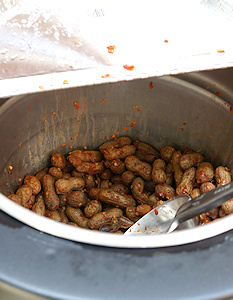  |
| After the kick of spicy boiled peanuts, put out the fire with delicious peach cobbler ice cream. |
Also on the first-base side, Whitt’s serves Clingstones Signature Peach Cobbler Ice Cream ($8), which is as tasty and creamy as I’ve ever eaten. Behind home plate is a kiosk that sells boiled peanuts, and if you’ve visited the South, you know how popular they are. A cup of the delicacy is $6 in either original flavor or cajun (above left).
Since Columbus is so close to Atlanta, you won’t find Pepsi products here, only Coke. And that’s particularly appropriate since the inventor of Coca-Cola once lived in Columbus.
A brand-new element in the park is the video board in left field. Its high resolution screen allows for all pertinent game info as well as commercials. There are two other ribbon boards in the outfield, with their default message being the Synovus logo. I also found the sound system within the park to be top-notch.
I was thankful that the promotions and games between innings weren’t over the top like at some Minor League parks. They were fun, with no screaming into mics like at other venues.
The kids area isn’t down one of the foul lines like at most parks. Instead, it’s behind home plate just outside the arches. It has the typical inflatables.
I found the park to be quite family-friendly. And the mascot Fuzzy is appropriately playful with kids.
All told, I find the gameday experience at Synovus Park to be very positive and quite enjoyable. Riggleman calls this the “true form of Minor League Baseball. You have the entertainment factor, the group areas, the kids areas, all of it combined together to make this great, special atmosphere.”
Summary
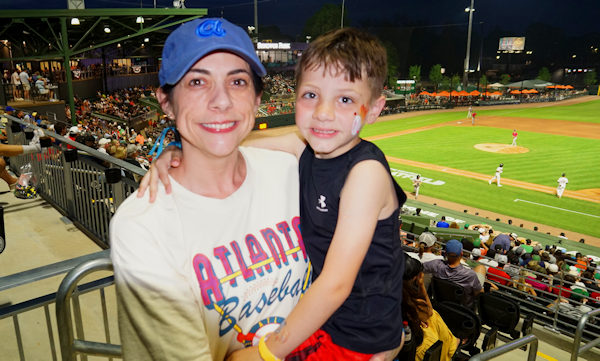
Whether you consider this a new ballpark or a renovated one, there is a lot to like here. And it didn’t take long to get rid of the bad taste in locals’ mouths from the lame-duck situation of 20 years ago.
“I interned for the RedStixx,” explained Cassie Denny of Smiths Station, Alabama, as she held her six-year-old son Beau (photo above). “It’s fantastic to have baseball back here so now we can share it with our kids.”
“On opening night, what I wanted to see was the faces of the kids,” said Mayor Henderson. “What I saw was the future — the future of this field, the future of our development, and the future of those kids and their kids one day.”
That’s what you get when you return the buzz and the energy.
Provide a comment below with your thoughts about Synovus Park or this review.
I appreciate the detailed article about the Columbus Clingstones new AA Baseball stadium at Synovus Park. I was able to walk through the park while reading it. Great Job!
Well written article, Joe! The ballpark sounds like the perfect combination of old and new.
Great review…headed there next month and also to Knoxville and Spartanburg. Thanks
Thanks for the kind words. My reviews of Knoxville and Spartanburg will be posted soon!
Love this article! Having lived in Columbus twice over the years, first for my own and then my wife’s stationing at Ft Benning, I have warm feelings for Columbus. Being a baseball — especially a MILB — fan, the news of a new team and stadium there was so exciting. Now having read your article I feel almost as if I have been there without having visited. Baseball is so nostalgic and you make the reader feel not only well informed but included! Thank you for taking the time!
Thank you for your very kind words, and thanks for noticing that I put a lot into reviews like this one!